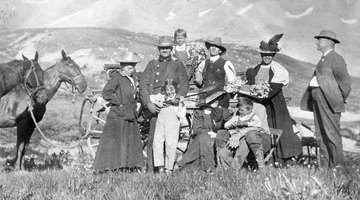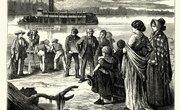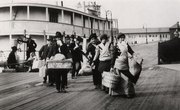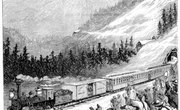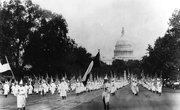America's first European settlers also were America's first immigrants. In some cases, they were welcomed by Native Americans, and in other cases, they were seen as a threat. By the 19th century, the pattern had been repeated many times, with each new wave of immigrants encountering mixed reactions from already established Americans. The German, Irish and Italian immigrants who arrived in America during the 1800s often faced prejudice and mistrust. Many had to overcome language barriers. Others discovered that the challenges they had fled from, such as poverty or religious persecution, were to be encountered in America as well.
Anabaptists and Anarchists
A mass migration of Germans began in the mid-1830s and continued into the 1880s when nearly 1.5 million Germans immigrated to America. Among them were Anabaptists, who were often persecuted for their belief in adult baptism. Most German immigrants settled in already established German communities and resumed their professions as farmers or skilled craftsmen. Their skills came to be resented by Americans, who felt the German craftsmen, merchants and tradesmen were creating too much competition. In 1848, several thousand German political activists immigrated to America to avoid arrest following their failed rebellion to force a unification of Germany. These new, outspoken immigrants, referred to as "Greens," often clashed with "Grays," the more established German immigrants who tended to lead quiet lives. The "Greens" later would become the target of anti-immigration groups who accused them of being anarchists.
Flight from Famine
The 1840 potato famine in Ireland left many Irish with two choices: immigrate to America or starve in Ireland. A majority of Irish immigrants settled in Boston, where the population of Irish increased from 30,000 to more than 100,000 in a year's time. The Irish were treated poorly as compared to Americans' treatment of German immigrants. Irish people often were caricatured in newspapers as illiterate drunks. Boston's English Americans looked upon Irish people as a servant race. Although more than 70 percent of Boston families' domestics were Irish, many Irish immigrants seeking jobs in any industry were met by signs reading "Irish Need Not Apply."
Same Village, Different City
Nearly all Italian immigrants who arrived in America in the late 1800s came from southern Italy and passed through the new immigration facilities at Ellis Island, New York. This wave of Italian immigrants were primarily farmers and unskilled laborers who settled the downtown sections of New York City. For these immigrants, the biggest challenge was their lack of marketable skills. Women often were employed doing piece-work from home and sometimes went days without seeing sunlight. Those women who worked outside the home faced the hazards of working long hours in sweatshops. Men took the work of unskilled laborers on municipal projects. Low wages afforded these immigrants the lowest tier of housing -- tenements. In some cases, a dozen or more people shared one or two rooms, in buildings plagued by infectious disease and vermin.
The Know-Nothings
The biggest challenge to immigrants in 19th-century America came from the rise in a movement known as nativism. The movement was supported by white, American-born Protestants who believed the swelling tide of immigrants and, in particular, the rapid growth of Catholicism in the United States were harming the public welfare. Middle- and upper-class citizens felt the majority of European immigrants were uneducated and would not be able to contribute to American society. Catholics, the nativists believed, were plotting to turn the country into a papal state. The Know Nothings were the most powerful of the nativist groups. Among the reforms they demanded of the government were a restriction of voting privileges for immigrants and the prohibition of immigrants and Catholics to hold public office.
Related Articles
References
Resources
Writer Bio
Laura Leddy Turner began her writing career in 1976. She has worked in the newspaper industry as an illustrator, columnist, staff writer and copy editor, including with Gannett and the Asbury Park Press. Turner holds a B.A. in literature and English from Ramapo College of New Jersey, with postgraduate coursework in business law.

